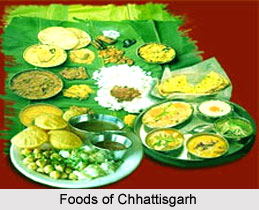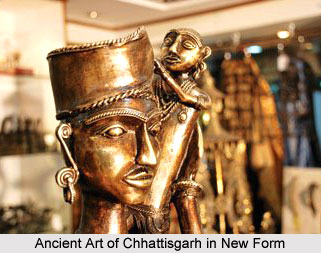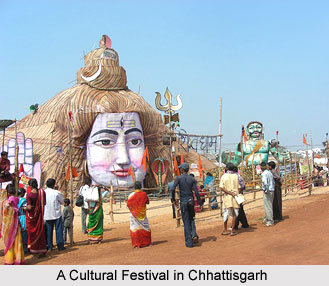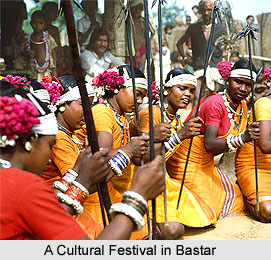 Chattisgarh is one of the eminent rural states of India. The union of tribal and non tribal culture, the harmonization of eastern and western art as a result of the British rule in India has added an articulation in the rich ethnicity and culture of Chhattisgarh.
Chattisgarh is one of the eminent rural states of India. The union of tribal and non tribal culture, the harmonization of eastern and western art as a result of the British rule in India has added an articulation in the rich ethnicity and culture of Chhattisgarh.
There was an intermingling of tribal and non- tribal culture, especially in the Bastar region and for these reforms of the 17th century, peasant revolts were duly responsible. In spite of this, Hindu culture, with due emphasis on Ram cult, is widely prevalent and also is growing in leaps and bounds over the years.
Music and Dance of Chattisgarh
Traditional music and dance are performed with joy and merriment down the generations and thus become an integral part of the social traditions and also becomes an undeniable element of the rich culture of Chattisgarh.
The music and dance are also a source of recreation and entertainment for the regional folks. The admirers of these indigenous music and dance forms are pretty huge in number; their enchanting rhythm and melodies mesmerized them and they made frequent visits to this area. Pandwani is the musical narrative of the Mahabharata. Teejan Bhai, the Padmashri award winner, is a renowned Pandwani artist who has hypnotized us with her unique style of dancing. The name of Ritu Verma is also familiar to us. Also Soowa dance form, the Panthi and the folk dance of shepherds namely "Raut Nacha is noteworthy. The dance styles ballets and comical plays, too, are in vogue. The people of this region love colours. They deck up with very colourful dresses while performing. Pandwani singing, Bharthari and Chandeni are famous forms of music from Chhattisgarh. It is striking that for every joyful occasion songs were composed; Sohar songs are connected to birth of the child, for weddings, Bihav songs are composed. The main components of Bihav songs are Chulmati, Telmati, Maymouri, Nahdouri, Parghani, Bhadoni. There are other songs for special occasions of marriage like Bhanver, Dowery and Vidai songs. Pathoni songs are the songs sung at the time of departure of bride to groom`s residence. Loriya and acting songs of child are Dandi Pouha, Loriya, Fugdi, Kau-Mau, Chau-Mau, Khuduwa (Kakdi), In Chhattisgarh, folk songs like Fag (songs for spring), Baramasi (12 months), Sawnahi
(songs of rainy seasons) are composed to commemorate seasons.
 Melodious songs were composed for various festivals. These are Cher-Chera songs, (celebrating growth of new crops, child songs), Dohe of Rout Nacha, Sua songs are sung at the time of Diwali celebration.
Melodious songs were composed for various festivals. These are Cher-Chera songs, (celebrating growth of new crops, child songs), Dohe of Rout Nacha, Sua songs are sung at the time of Diwali celebration.
Territorial folk melodies are Goura songs, sung during the adorations of Lord Shiva and Parvati in Diwali, Mata Seva songs, songs of Nagpanchami, Janvara songs, Bhojali songs, Dhankul songs. Danda songs, Karma songs and Dewar songs are purely for amusement.
Festivals of Chhatisgarh
Various festivals and fairs that are celebrated in Chhattisgarh reflect the traditional culture of Chhattisgarh. Through out the year the people of Chhattisgarh are busy celebrating various festivals in full vigour.
Dusshera is one of the important festivities, especially in Bastar region. Like any other states of Indian subcontinent the people celebrate it with exuberance, it varies in its commemorative theme. It is no longer a celebration to mark the occasion of victorious coming back of Lord Rama in his hometown of Ayodhya.
The residents of Bastar region, mainly belonging to the tribal communities, these days celebrate it in worshipping goddess Danteswar the festival is celebrated through out Chhattisgarh. Another festival namely Madai is celebrated in pomp and grandeur in various villages stretching from Baster to Mandla provinces of Bihar. In Bastar, Gond tribe celebrates this festival in high spirit. By gathering under the shed of a holy tree, myriads of devotees guillotine the goats as a mark of sacrifice to the goddess. Huge fiesta is being followed after that. Among the Bhil tribes, the Bhagoria Festival is immensely popular. They worship the dance god called Bhagoriya. This is the joyful festival where young girls and boys dance and express their feelings of love for each other. On the day of Raksha Bandhan, Chhatishgarhis celebrate Kajari Festival. Hariyali heralds the celebration of rich harvest time. It is held in monsoon season where the peasants revere the cows and the farming tools. Hanging threads of leaves of neem trees is done to remove all evil forces and pray for hefty crops. Charta festival, the festivals for tribes of Chattisgarhi, commence with the collection of rice from the huts of every villager by the children. Married women cook rice on the banks of the rivers and ponds.
 Navakhana is the festival marking robust harvesting. It starts with the offer of reaped rice to the Gods of the family on the day of Navami. Rampant drinking and dancing goes on throughout the night.
Navakhana is the festival marking robust harvesting. It starts with the offer of reaped rice to the Gods of the family on the day of Navami. Rampant drinking and dancing goes on throughout the night.
Surhul festival is committed to the reverence of `Mother Earth`. It takes place at the time when `Sal` trees are in full bloom. The villagers pray at a small forest in the village locality called Sarna and for the day the fields remain unscratched.
Goncha Festival at Jagdalpur is the chariot festival in Chhattisgarh. The tribes from several region of Bastar participate. It is feted in the month of July, at the time of Rath Yatra. The tribal communities make use of bamboo `tukki` and fruit `goncha` and apply them as weapons.
Other important festivals of Chhatisgarh include Kora, Chaitrai, Hariyali, Gouri-Goura, Surti, Pola, Teeja, Navakhana, Deepavali, Holi, Govardhan Pooja, Mati Puja, Charta and Navakhani.
Many colourful fairs also are organized. Bhoramdeo Mahotsav is held in the month of March in the premises of Bhoramdeo temple constructed by King Ramachandra of Nag Dynasty.
Cuisine of Chhatisgarh
The cuisine of Chhatisgarhis follows the typical Oriental style. They are prone towards using lots of spices, flavours and aroma in their food. The typical culture of Chhattisgarh ideally unfolds the fact that "garam masala" is a spice mixture widely prevalent in this area. Sunflower and canola are mostly used vegetable oils used in the cooking. Rice, bread, `rotis` are commonly used by the people. Wheat, jowar, bajra are the staple food for the people. The Chhatisgarhis are also fond of typical non- vegetarian items like chicken, eggs, meat. Especially the tribes, relish chicken, mutton, beef without roasting or grinding.
 Different preparations of dals (lenthils) are cooked along with brinjal, potatoes, gourd, pumpkin and many green vegetables like cabbages, ladies finger, and spinach. Pickles and `chutneys` are part and parcel of the cuisine of Chhatisgarhis. Most people have developed a taste for Arhar dal. Another common dish is `Bafauri` which is cooked from `Chana dal`..
Different preparations of dals (lenthils) are cooked along with brinjal, potatoes, gourd, pumpkin and many green vegetables like cabbages, ladies finger, and spinach. Pickles and `chutneys` are part and parcel of the cuisine of Chhatisgarhis. Most people have developed a taste for Arhar dal. Another common dish is `Bafauri` which is cooked from `Chana dal`..
There is a wide variety of sweet delicacies available for the people. Jalebi is hot- favourite to the people. Most favourite sweets of Chhatisgarh include `Laktho`, `Khurma`, `Balushahi`, `Anarasa`, `Khaja`, `Ladoo`, `Rasgulla`. Besides, Khaja, Kala Jamun, Peda and sumptuous halwas are indispensable for the sweet-lovers. A traditional sweet dish Maipua is prepared from flour, milk, sugar, "mauri`. These mouth watering delicacies gratify the hunger lust of Chhatisgarhis.
Art and Culture of Chhatisgarh
LOHA SHILPA: The dark raw forms of the metal artefacts and figurines of Chhattisgarh, appear as a sign of its own people. Both share a roughness that is underlined by quiet elegance and dignity. The raw material used for this craft is predominantly recycled scrap iron, with the rich ore mines of Cherangdungri occasionally acting as the supply source. The method of manufacture is easy, yet effectual. Metal is made pliable by beating it in furnaces and then shaping it carefully into a basic form. Mastery over the craft is evident in the fact that no joints show in the products. On completion, a coating of varnish is applied to enhance its lustre.
DHOKRA: The bell metal craft is produced extensively in the areas of Lalitpur, Raigarh Districts, Sarguja Districts and most importantly in Bastar. Dhokra essentially refers to the casting of bell metal or brass using the `lost-wax` technique. In Chhattisgarh, it is the Ghadwa community that is associated with this craft. Interestingly, in local etymology, Ghadwa means `to shape`.
A variety of products are created by the Ghadwas for local use such as effigies of regional deities, vessels and jewellery. The traditional lost wax technique is simple and ideal for use in tribal settings. The craftsman begins by winding a slim thread of wax over the contours of a clay core. It is then thickly coated with fine clay obtained from termite hills, and baked on drying, leaving a narrow vent to melt away the wax. The vacuum created between the core and the clay layer is filled with molten metal, which is then allowed to cool down and solidify. The outer clay mould is cracked open, revealing the beauty of the final sculpture. It requires great precision and skill. The metal must be able to flow uniformly and freely through the narrow spaces, and replace the wax without forming any bubbles or gaps. Cow dung, paddy husk and red soil are also used in the manufacture of Dhokra artefacts. Of all the raw materials used by the Ghadwas, the most important is beeswax. Besides the essential contouring, wax wires and pieces are also used for decorations required for finishing the artefacts. It is used because of its extraordinarily high plastic content and pliability, generating a rudimentary but powerful stimulus for the intricate design of the artisans. The basket makers would wind grass around a rope, which was then coiled into shape. The same technique was translated into metal only much later, with forest dwellers being dependent on natural product long before they began to use metal. Metal anklets with basket weave motifs and beautiful containers reminiscent of wicker baskets also point towards such a transition.
KASHTA SHILPA: Bastar region`s extensive forests offer a range of fine trees - sheshum, rosewood and Indian teak traditionally thrive in the region. Initially, the tribal communities used the forests for the wood for basic firewood and shelter needs. Over time they learnt to use wood for carving and refined forms of carpentry, precipitating in the emergence of a community of people skilled in this craft called the Badais community. These people then diversified into two groups - one produce agricultural instruments and others are crafting decorative and totemic pillars. Simple tools made of wood or bamboos are used. The instruments are "kaas", "sala poh", "poh" and many others. The youth dormitories of the Muria once stored dancing stilts, carved wooden head gear or "Kutual", and large drums used during the dances. Motifs such as combs, sun and moon, floral and geometric designs also appear alongside. Beautiful wooden ceilings, doors and lintels using wide-ranging species of wood are commonly used in the homes of the region. The craftsmen also make pipes, masks and sculptures using fragrant varieties of wood.
TERRACOTTA: The art of sculpting clay is the point of genesis of Chhattisgarh`s artistic expressions. The expertise and skills required for producing the terracotta artefacts. These have been handed down from one generation to another of the Kumhara community. The Kumharas source the raw material from the Indravati River. The upper river soils are used to create the clay forms by using rudimentary tools - potters wheel and wooden machines. Many hours in a gentle slow fire imparts strength and stability to the creations. They are finally coated with the deep river soils that lend a dark sienna tone to the elegant figures. Potters create Matkas, pots, Handiyas, bowls and lamps. Contemporary forms like pen holders, lamps, and paperweights are also created, in keeping with modern day requirements.
OTHER CRAFTS: Bamboo products and baskets are necessary part of tribal life. Bamboo is used for constructing houses, making bows and arrows, handles for agricultural tools besides other useful products. The Bansods of Chhattisgarh make more than two hundred different varieties of bamboo products including a large variety of baskets. The Kamar tribes of Raipur are expert in making baskets and other items like fish and bird traps, mats and other objects from bamboo.
In comparison to all other states of Indian subcontinent Chhattisgarh is a newly born. However if we consider the rich heritage of its cultural proponents it can be easily vied at par with the rest of India.






